Nonconventional Alternatives to LC–MS
Special Issues
An important attribute of a novel ionization process for use in mass spectrometry (MS) is its simplicity and flexibility to be hyphenated to conventional liquid-based separation methods.
An important attribute of a novel ionization process for use in mass spectrometry (MS) is its simplicity and flexibility to be hyphenated to conventional liquid-based separation methods. The new solution-based ionization process described here provides exciting opportunities for nonconventional alternatives to interfacing liquid chromatography (LC) with MS. Combining LC separation with ion mobility spectrometry (IMS) provides additional separation of gas-phase ions. These technology developments have potential for extending MS to areas of high-performance characterization using advanced fragmentation technology (for example, electron-transfer dissociation) as well as to areas where cost, robustness, and simplicity are important assets such as clinical settings and field-portable instruments.
Mass spectrometry (MS) provides a means of detecting and characterizing compounds with exceptional sensitivity and dynamic range relative to most other analytical technologies. To enable any means of characterization by MS, efficient ionization is necessary to convert molecules to measurable units: gas-phase ions. Unfortunately, no single ionization method is capable of ionizing all components of complex mixtures to give a representative view of the molecular composition. In addition, sample preparation can be detrimental to converting solution or solid-phase molecules to gas-phase ions. As an example, matrix-assisted laser desorption–ionization (MALDI)-MS (1,2) of β-amyloid peptides obtained using solvent-free sample preparation preferentially ionizes nonpolar compounds while solvent-based sample preparation ionizes polar compounds (3). An additional difficulty is that compounds are present in biological systems in widely different concentrations, requiring analytical methods that have a high dynamic range (4). In spite of sensitivity enhancements in MS, the dynamic range for direct analysis remains limiting relative to the concentration ranges present in biological materials. Enhanced dynamic range is achieved by interfacing ionization with liquid chromatography (LC) (5), ion mobility spectrometry (IMS) (6,7), or a combination of both (8). The near-instantaneous separation afforded by IMS and MS reduces complexity, provides information about the size and shape of ions (9), and is applicable for materials analysis (10,11) even without prior separation using LC (12).
The recent development of high performance mass analyzers enormously advanced mass measurement in terms of mass resolution and mass measurement accuracy. Additionally, structural characterization is enhanced using newer ion fragmentation methods like electron-capture dissociation (ECD) (13) and electron-transfer dissociation (ETD) (14), and interfacing IMS with MS provides inroads to the determination of structure (shape) (15,16). These capabilities are facilitated by the production of multiply charged ions. The standard methods for coupling LC with MS is electrospray ionization (ESI) (17) and atmospheric pressure chemical ionization (APCI) (18); MALDI is only applicable through off-line fractionation (19). Here, we describe new ionization methods for coupling LC to MS as well as ways to circumvent the use of LC altogether.
Novel Ionization Methods Coupled with LC–MS or IMS–MS
The recent discovery of a novel ionization process has been developed into a series of ionization methods that produce ESI-like mass spectra from the solution or solid states and provide excellent alternatives to MALDI and ESI (20–22). These ionization methods rely on heat (temperature) or the vacuum (pressure) present with any mass spectrometer instead of high voltage as in ESI or a laser as in MALDI. The novel methods use a suitable matrix that can be either a solvent or solid small-molecule compound (23–26). The methods are easy to apply and cost effective, and can provide enhanced analytical results. The ion source is greatly simplified by eliminating lasers, high-voltage supplies, and nebulizing-desolvation gases. Multiply charged ions produced by these methods extend the mass range of high-performance mass spectrometers (27,28), enhance separations in IMS (28–34), provide excellent mass resolution (25,35–42), and facilitate advanced fragmentation using ETD (35,36,43). Interested readers are referred to recent summaries (20–22).
Basics of the New Ionization Process
The novel ionization methods were introduced by the Trimpin and McEwen groups and produce gas-phase ions having charge states similar to those observed with ESI when a solution or solid matrix compound containing analytes enters a heated inlet tube linking atmospheric pressure with the first vacuum region of a mass spectrometer. Methods in which gas-phase ions are produced from within the heated inlet tube and the first vacuum region of the mass spectrometer were initially termed inlet ionization (23,27,37). Subsequent research demonstrated that with the proper matrix, multiply charged ions can be produced simply by exposure of the sample to vacuum, a method termed vacuum ionization (28,32). In inlet ionization, the matrix can be a solvent (Figure 1a) and does not require high voltage or a laser to produce ions from solution (23,28). However, a voltage can be applied to the solution to produce ESI-like results; this ESI based approach is termed electrospray ionization inlet (ESII) (Figure 1b) (44). Both solution based methods produce abundant multiply charged ions, but each method has different selectivity (23,44). Inlet ionization is also applicable to the introduction of an analyte in a solid matrix into the inlet.

Figure 1: Schematic representation of (a) solvent-assisted ionization (SAI), (b) electrospray ionization inlet (ESII), and (c) matrix-assisted ionization (MAI) in which the laser can be used to dislodge the matrix–analyte from the holder.
To simplify acronyms associated with the related novel ionization methods that require neither a voltage or a laser, we will refer to those that use a solid matrix simply as matrix-assisted ionization (MAI) (Figure 1c) (37), and those that use a solvent as matrix will be referred to as solvent-assisted ionization (SAI) (23). A laser can be applied with MAI in cases where high spatial resolution is needed. Thus, small molecules such as 2,5-dihydroxyacetophenone (DHAP) when used as a matrix in high concentration and containing parts-per-million to parts-per-billion amounts of analyte produces gas-phase analyte ions with excellent sensitivity when tapped (37) or ablated with a laser into the heated inlet of a mass spectrometer (35). The Trimpin group recently demonstrated that with the proper matrix, heating the inlet is not necessary (28,33). The matrix 3-nitrobenzonitrile (3-NBN) sublimes when exposed to subatmospheric pressure and, when used as a MAI matrix, provides enhanced sensitivity, low chemical background, and (because it sublimes) readily pumps from the mass spectrometer, thereby eliminating matrix-related contamination. These solid-phase methods, which have sample preparation protocols similar to MALDI, while not readily applicable with LC–MS (45), can be used effectively with IMS–MS to provide ionization, separation, enhanced dynamic range, and structural information.
In inlet ionization, we hypothesized the first charges appear on matrix-solvent droplets traversing the heated region between atmospheric pressure and vacuum (46). In this mechanism, solid matrices were thought to produce molten droplets by laser ablation or within the hot inlet tube. It was speculated that the mechanism for droplet charging involves rapid microbubbling, as in boiling, in which the surface charge is partially separated from the parent droplet in the thin liquid layer at the surface of the bubble (46–48). Bursting the bubble carries away this charge (usually negative) in small droplets, leaving highly charged (usually positive) larger droplets. Thus, the charge separation process allows observation of either positive ions from parent droplets or negative ions from the surface droplets. Evaporation of the solvent or matrix from the charged droplets is proposed to produce gas-phase ions by the same mechanisms as in ESI. Only after the matrix (solvent or small molecule) is removed from the charged droplets can the bare analyte ions be mass measured in the mass analyzer. This mechanism explains the very similar mass spectra observed with all inlet ionization methods and ESI. However, the mechanistic approach now seems too simplistic in light of the findings that matrices such as 3-NBN produce nearly identical mass spectra without added heat (25,33), and therefore must do so from the solid state.
Inlet ionization is believed to also involve gas-phase ionization of volatile analytes. Charge separation occurs as discussed above, but in addition to analyte ions, matrix ions are also produced. Neutral volatile analyte molecules are vaporized in the inlet and become ionized by collisions with gas-phase matrix ions. Thus, two mechanisms are thought to be responsible for ionization, similar to combining ESI and APCI, allowing a wide variety of compounds and numerous applications to be amenable to this method. Higher inlet tube temperatures (>350 °C) favor the gas-phase mechanism, whereas intermediate temperatures (250–350 °C) favor the ESI-like process. Many compounds, small and large (46), introduced neat into the inlet also produce gas-phase ions, possibly from a charge separation process in which the analyte is its own matrix.
Nonconventional Approaches to LC–MS and IMS–MS Based on Solvent as Matrix
In inlet ionization, the source housing is removed and the heated inlet tube becomes the new ion source. Without the source housing, SAI is readily interfaced with LC–MS or LC–IMS-MS. The outlet of fused-silica tubing carrying the LC effluent is placed directly into the heated inlet tube of a mass spectrometer. This is easily accomplished with mass spectrometers (for example, Thermo Scientific) that use heated inlet tubes to link the vacuum of the mass spectrometer with atmospheric pressure. Mass spectrometers without heated inlet tubes need to be modified. As noted above, both charge separation to form positively and negatively charged droplets and desolvation of those droplets occurs in the inlet. However, collisions with surfaces, including the walls of the inlet, and gases, as well as radiofrequency fields later in the instrument, enhance the process of producing the bare gas-phase ions detected by the mass spectrometer.
SAI not only extends the methods available for interfacing LC with MS, but allows various sampling arrangements to be used without the need for high voltage, desolvation gases, or proper "spray conditions." For example, liquid junction (solvent bridge) experiments can be performed in which the solvent touches a surface, thus removing compounds by extraction, while the liquid junction solution is automatically drawn into the mass spectrometer inlet tube by the pressure differential between the solvent bridge droplet and the lower pressure of the inlet tube (49). Likewise, laser ablation of, for example, a tissue section in a way that ablated material is captured by the liquid junction provides a high spatial resolution sampling method (21). Pipette tips can also be used to deliver solution to the inlet tube for ionization by SAI (50). Using this approach, automated high-throughput studies using SAI were recently demonstrated where the location and the relative amounts of target compounds present in 96-well plates were automatically identified (51). In these direct injection ionization methods, IMS is an important additional separation dimension for reducing spectral complexity and increasing dynamic range.

Figure 2: Mass spectra for polystyrene (PS) 1000 with AgTFA salt in 100% tetrahydrofuran using SAI at inlet temperatures (a) 250 °C and (b) 450 °C acquired on an LTQ Velos mass spectrometer (Thermo Fisher Scientific). Adapted from reference 50 with permission.
Relative to ESI, SAI has less dependence on solvent type because even 100% water or organic solvent can be used (51). An example is shown for the analyses of a synthetic polymer using tetrahydrofuran as solvent. Different charge states and adduction patterns were seen when 1 μL of a 20 pmol/μL solution of polystyrene 1000 containing AgTFA salt in tetrahydrofuran was directly introduced into the inlet of a LTQ Velos MS system (Thermo Fisher Scientific) at inlet temperatures ranging from 250 °C to 450 °C (Figure 2) (50). Similar to ESI, SAI produces multiply charged ions that allow advanced fragmentation technologies to be used for structure elucidation (52). Myelin basic protein (+4 ions) was ionized by SAI and fragmented by ETD using a Thermo LTQ Velos MS system (Figure 3a) (43), achieving high sequence coverage. Similar sequence coverage was obtained using MAI.
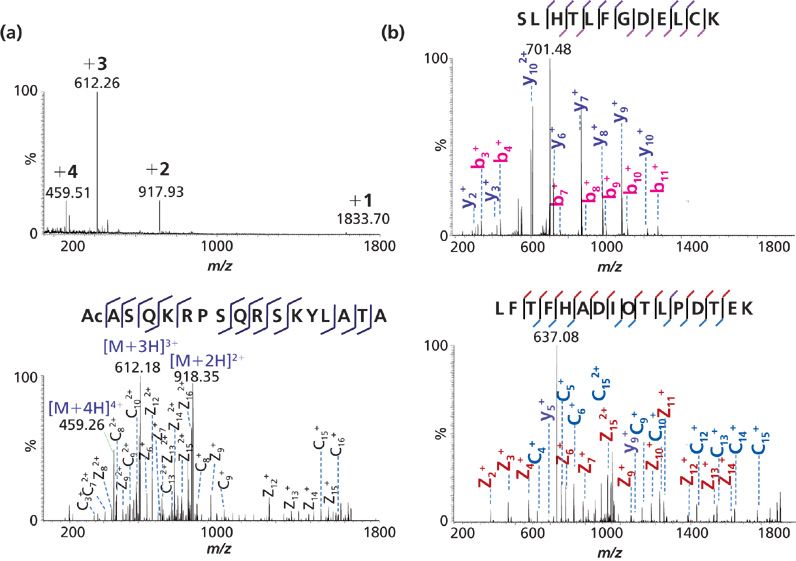
Figure 3: (a) SAI and ETD mass spectra of the +4 myelin basic protein dissolved in water–0.1% formic acid: MS (upper) and MS-MS (lower) with inlet temperature 250 °C using a Thermo LTQ Velos MS system. Similar results were obtained using MAI with and without the laser. (b) LC–SAI-MS-MS of peptides of a BSA tryptic digest separated on a 100 mm × 1.0 mm C18 BEH300 column (Waters) with acetonitrile–water–0.1% formic acid mobile phase at a flow rate of 55 μL/min using CID for the peptide SLHTLFGDELCK (upper) and ETD of the peptide SLHTLFGDELCK (lower).
SAI has been shown to have exceptional sensitivity for small molecules without basic functional groups, such as steroids (low parts per billion), as well as good sensitivity for large molecules such as peptides (7 ng of a bovine serum albumin [BSA] digest) (52–54). Interfacing SAI with LC–MS has been demonstrated at flow rates of 55 μL/min for 1-mm i.d. LC columns (54), and at 400 nL/min for capillary columns (53,54). Fused-silica tubing directly connected to the LC column can be used at flow rates as low as a couple of microliters per minute, but for low-flow SAI, picotips (commonly used with nanoflow ESI) are necessary (52). The LC–SAI-MS-MS spectra of BSA tryptic digest peptides fragmented using collision induced dissociation (CID) and ETD are shown in Figure 3b. In addition, LC–SAI analysis of 200 fmol of BSA digest is shown in Figure 4.
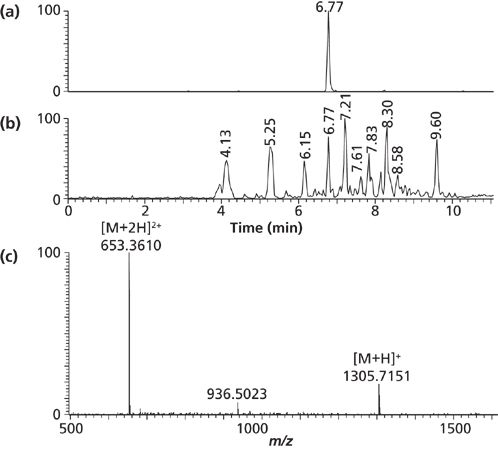
Figure 4: LC–SAI-MS of 200 fmol of a BSA digest acquired on an Orbitrap Exactive system (Thermo Fisher Scientific) at 100,000 mass resolution (1-s scans) using a 55 μL/min flow rate and water–acetonitrile–0.1% formic acid mobile phase. (a) Extracted chromatogram of the base peak at 6.77 min. (b) Base peak chromatogram of BSA digest. (c) Mass spectrum of peptide extracted from the chromatogram at retention time 6.77 min.
The fused-silica tubing used to introduce solution into the heated inlet tube for SAI can be connected to the LC column directly or through a metal union. If no voltage is applied to the union, SAII mass spectra are obtained. However, applying between 1 and 2 kV to the metal union increases the abundance of compounds that ionize well using ESI. Different ionization selectivity is achieved by simply switching a voltage on or off. Figures 5a and 5b show a comparison of LC–ESII-MS and LC–ESI-MS using the commercial ESI probe on an LTQ Velos MS system for 100 fmol of BSA tryptic digest injected onto a 50 mm × 1.0 mm C18 BEH300 column (Waters) at a flow rate of 50 μL/min. Not only is the signal-to-noise ratio of the base peak chromatogram substantially improved using ESII, but more peaks are observed. The mass spectrum of the BSA tryptic peptide "ATEEQLK" eluted at 5.07 min in the ESII acquisition is shown in Figure 5c. At this concentration, no ions are observed for this peptide by ESI. Similar improvements are observed with small molecules using ESII.

Figure 5: Base peak chromatograms of 100 fmol of BSA tryptic digest separated on a Waters NanoAcquity LC system interfaced with a Thermo LTQ Velos mass spectrometer using a 50 mm × 1.0 mm C18 BEH300 column with an acetonitrile–water–0.1% formic acid gradient at a flow rate of 50 μL/min with (a) ESII and (b) ESI. (c) The ESII mass spectra of the peak at 5.07 min (the ion at m/z 409.8 is not observed in the ESI acquisition).
Nonconventional Approaches Using Small Organic Molecule Matrices
There are analyses that are better suited to the use of a solid matrix, as with MALDI, rather than a solvent. The advantages of MAI directly from atmospheric pressure relative to MALDI include:
- No laser requirement and thus no reduction in mass resolution or mass measurement accuracy associated with high laser power.
- Interfacing with common atmospheric-pressure mass spectrometers that often have advanced resolution, IMS, and MS-MS capabilities.
- The potential to use various atmospheres that prevent undesired oxidation as sometimes observed in ESI (55) or reduction as sometimes observed in MALDI (56).
- If needed, use of laser ablation for rapid high-spatial-resolution analysis facilitated by the need of only a single laser pulse per pixel.
For example, MAI is well suited for surface analyses. Monolayer films of Fe(III) and Mn(III) complexes were problematic or failed using ESI and MALDI, but were analyzed using MAI (57). ESI and MALDI were either too insensitive for monolayer analyses, or too harsh to ionize and characterize these fragile molecules (58).
Although most analyses are enhanced by incorporating a solution-based separation step before mass analysis, it is not practical using solid matrices. Furthermore, the separation increases the time of analysis and requires a soluble sample. In addition, some analyses do not easily lend themselves to prior liquid-phase separations such as surface analyses. In these cases, direct analysis by MS can be applied. High-resolution mass spectrometers offer excellent separation of compounds that differ in mass. Disadvantages of direct MS analyses include ion suppression and limited dynamic range. Adding ion mobility separation reduces spectral complexity, has the ability to separate isomers, and provides enhanced dynamic range to the measurement. Thus, inlet ionization using a solid matrix such as 3-NBN offers a number of advantages, especially with high-resolution mass spectrometers and those with IMS capability. The method is easy, fast, sensitive, and can be applied to surfaces.
With MAI, the matrix is dissolved in an appropriate solvent and combined with analyte, or alternatively, the matrix in solution is applied to a surface to be analyzed. Over 40 matrix compounds have been discovered that produce analyte ions when exposed to vacuum with little or no applied heat (25). Similar to MALDI, we expect different matrix materials will provide different selectivity and sensitivity, as initial results indicate (59). Unlike MALDI, no laser is required and the method works with mass spectrometers having atmospheric-pressure ionization capabilities simply by introducing the matrix to the inlet aperture. In addition, solid matrix compounds offer the potential to use solvent-free sample preparation methods originally developed for MALDI (3) and later with MAI (25,60). MAI also does not require the matrix be dry when introduced to the mass spectrometer inlet (24,25), although a dry matrix usually provides better sensitivity. Thus, simply using a pipette tip, approximately 1 μL of matrix–analyte solution can be injected directly into the inlet or pushed from the pipette and allowed to dry before introduction into the inlet of the mass spectrometer.
When analyte solution is introduced to the skimmer cone inlet of the Z-Spray source of a Waters Synapt G2 with the inlet block held at 50 °C without added matrix, no ions of either ganglioside lipids or the small protein bovine insulin are observed, as expected, because the inlet temperature is too low for SAI. However, when the MAI matrix, 3-NBN, is mixed via a T-junction to the analyte solution and the combined matrix–analyte solution enters the inlet, using the same mass spectrometer conditions, abundant ions are formed with essentially no chemical background. Multiple charging allows detection of higher molecular weight compounds by the mass range limited mass spectrometer as is exemplified for bovine insulin (positive mode, Figure 6a) and, in addition, is soft enough to not destroy the fragile ganglioside lipids (negative mode, Figure 6b). This approach has the potential of being interfaced with LC–MS and requires no voltage, nebulizing gas, or heated inlet tube. Although it may seem counterproductive to add a matrix compound continuously to a mass spectrometer, we have run an experiment in which 5 g of 3-NBN in solution was introduced to a pumped glass enclosure over several hours without any sign of residual matrix on the glass.
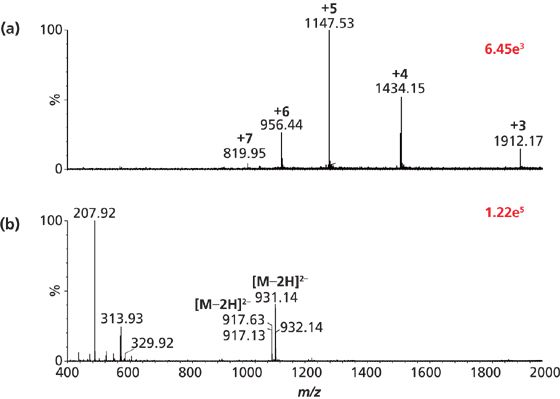
Figure 6: Mass spectra obtained mixing the MAI matrix 3-NBN in acetonitrile solution with the analyte in 1:1 methanol–water using a T-junction with a total flow rate of 2 μL/min acquired on a Waters Synapt G2 mass spectrometer with the inlet at 50 °C: (a) bovine insulin, (b) ganglioside lipids.
As an example in which LC–MS required considerable effort, or failed entirely, we recently demonstrated that MAI provides a rapid method for differentiating between a europium-containing two-arm and one-arm PEG conjugate (59). MAI-IMS-MS readily differentiated these species in minutes, including interpretation. This combination of technologies provide a detailed view of the mixture directly from the crude sample because of the high abundance of analyte ions as well as formation of multiply charged ions that are better separated in the IMS dimension than those of singly charged ions produced by MALDI (28–34).
The MAI ionization process occurs rapidly, requiring as little as 4 s per sample when the source temperature is elevated to 80 °C. A recent study demonstrated automated fast analysis using MAI (61). It was also demonstrated that MAI-MS can be readily coupled with IMS for a rapid untargeted approach for MS-MS (Figure 7). The fast gas-phase separation of IMS complements the speed of the MAI ionization method, allowing for near simultaneous separation and analysis. Using this method, eight drug and peptide samples were characterized without precursor ion selection in just over 2 min. The fragment ions were then assigned based on their mobility by the provided MS-MS software. The speed of analyses and absence of exchangeable protons on the matrix also minimizes back exchange of deuterated peptides (62).
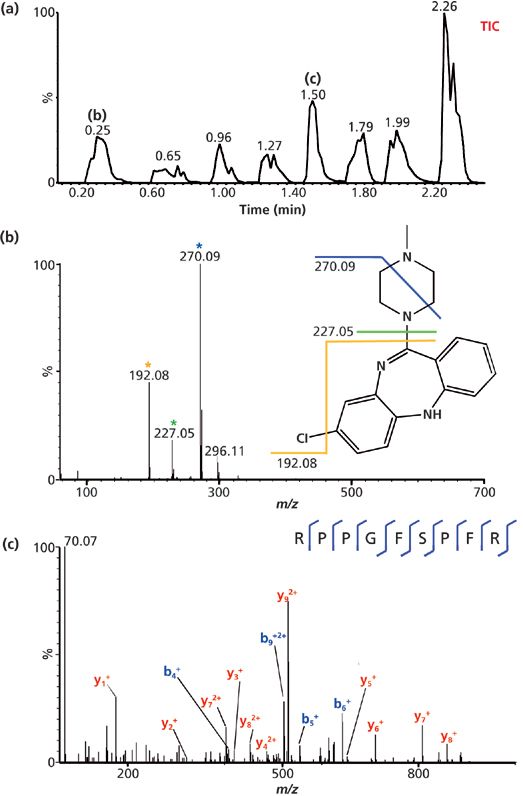
Figure 7: Characterization of four drugs and four peptides in 2.40 min using a Waters Synapt G2 MS system with the inlet at 60 °C and using 3-NBN as the matrix. Samples were introduced sequentially to the vacuum inlet of a mass spectrometer using an eight-channel pipette. (a) TIC of the total analysis, (b) MS-MS spectrum of clozapine, and (c) MS-MS spectrum of bradykinin. Precursor ions were fragmented by CID in the transfer collision cell after IMS separation.
Similar to MALDI, 1 μL of matrix can be deposited on a tissue section and introduced to the mass spectrometer vacuum (either ESI or MALDI sources) (28,34,36,49). Ions are observed from these complex biological materials without the use of a laser. As expected, because of the large number of compounds present, rather complicated mass spectra are obtained that become more easily interpreted when the additional separation dimension of IMS is used (28,34,49). For example, quantitative analysis of the antipsychotic drug clozapine from mouse brain tissue was demonstrated using SAI and MAI and compared to results using conventional LC–ESI-MS and MS-MS using CID (49). Both novel ionization methods fared well with the advantage of speed over the traditional approaches.
Applying LC–MS to surface analysis is fraught with difficulties, but MAI-IMS-MS provides direct and rapid surface analysis with the drift time dimension giving additional insights. An example shown in Figure 8 is an isomeric mixture of beta amyloid (amino acid residues 1–42) peptide, which holds biological significance in Alzheimer's disease (63) and the reversed peptide (amino acid residues 42–1). These peptides were ionized using MAI and the isomers show baseline separation in the IMS dimension based on shape differences. Furthermore, MS-MS using CID confirmed the identity of the isomers (34).
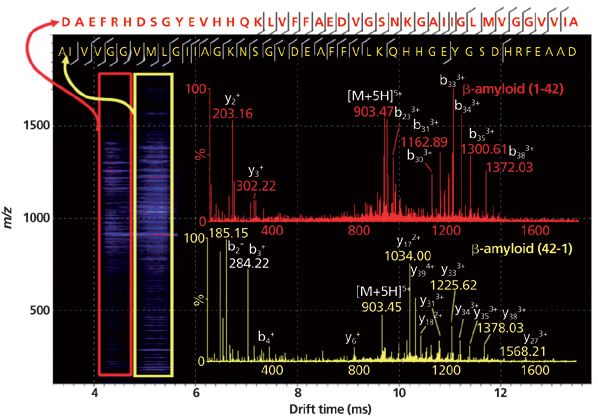
Figure 8: MAI-IMS-MS-MS of isomeric mixture: The 2D plot of an isomeric mixture of beta-amyloid (1–42) (in red) and (42–1) (in yellow) using MAI with 3-NBN as matrix. The charge state 5+ precursor ion was separated in IMS, thereafter selected in the quadruple and fragmented in the transfer region using CID data that was acquired on the intermediate-pressure vacuum MALDI source of a Synapt G2 mass spectrometer. The fragment ion mass spectra and sequence coverage of both isomers are overlaid in the 2D plot.
While some surface spatial resolution (approximately 1 mm2) is directly achievable using MAI (28,34,49), it is currently well below the resolution achieved using laser ablation (approximately 20 μm) (36,64,65). However, if higher spatial resolution is needed with MAI, a laser can be used with atmospheric- or intermediate-pressure ion sources to produce multiply charged analyte ions directly from a surface. Using this approach, multiply charged ions from endogenous peptides were directly imaged from mouse brain tissue with a spatial resolution of 100 μm (31) on the commercially available Synapt G2 MALDI source with the laser alignment in reflection geometry and 2-nitrophloroglucinol as a MAI matrix. Characterization of an endogenous peptide was achieved using ETD and ultrahigh mass resolution (36). The drift times observed from the complex mixture and the purchased peptide standard are essentially the same (32). Similar success of imaging tissue samples using MAI matrices and laser ablation were reported by the groups of McEwen and Li (40,42). Recently the Trimpin group reported the detection and separation of the doubly deprotonated lipids directly from a 10-μm-thick mouse brain tissue sample in negative ion mode using transmission geometry LSI-IMS-MS. The lipids were tentatively assigned as fragile cardiolipins and disialogangliosides (GD1) (Figure 9) (66). Further developments in transmission geometry laser ablation technology are expected to enable high-performance imaging and characterization of multiply charged protein species directly from tissue, and the use of the IMS dimension will be critical in improving the dynamic range and providing a degree of separation.
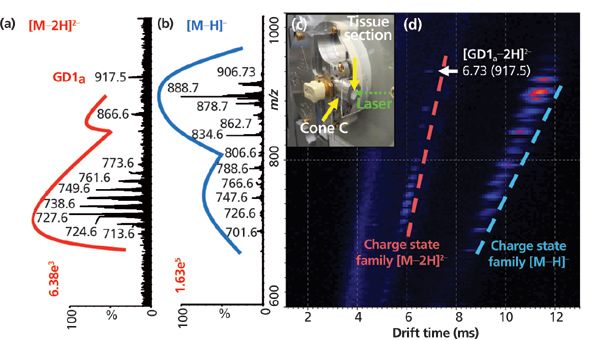
Figure 9: LSI-IMS-MS directly from mouse brain tissue in negative ion mode using transmission geometry as laser alignment. (a) extracted mass spectrum of [M–H]–; (b) extracted mass spectrum of [M–2H]2–; (c) photo of entrance region of the LSI source with a mouse brain tissue section on a glass plate adhered to cone C; (d) 2D plot of drift time versus m/z with lines indicating separated charge state families. Data were obtained on a Waters Synapt G2 MS system with a source temperature of 80 °C and using 3-NBN as matrix.
Outlook
A Small Business Technology Transfer (STTR) Phase I grant has been awarded by the National Science Foundation (NSF) for fundamental research aimed toward commercialization of the novel ionization technologies described above (67). The ability to combine MAI, SAI, ESII, and nanoESI in a single platform has been demonstrated. Fundamental aspects related to ion formation as well as various approaches for rapid and simplified analysis even under conditions where spatial information is preserved are being explored. While the liquid introduction ionization method of SAI and ESII have the potential to provide a substantial improvement for LC–MS analyses using 0.3–1.0 mm i.d. LC columns, the simplicity, speed, and low operational requirements of MAI seem ideally suited for a wide variety of applications including clinical analyses and field-portable mass spectrometers (34,62). Deposition of less than a microliter of matrix solution onto tissue is sufficient to obtain a rich mass spectrum from only the area impacted by the matrix solution. From an operational standpoint, the tissue (or solid or solution matrix containing analyte from paper, mesh, pipette tip, and so forth) only needs to be exposed to the vacuum at the inlet of a mass spectrometer. Optimization of this methodology will require modification of instrument inlets similar to what was done for ESI and MALDI over decades.
Conclusion
The development of a flexible ion source for solutions (nanoESI, SAI, ESII) and solid matrices (MAI) that can be coupled with LC or IMS-MS and use new fragmentation technology (for example, ETD) will be important in advancing fundamental knowledge and analytical materials characterization using MS. Currently, competitive sensitivity with ESI as well as atmospheric and intermediate pressure MALDI have been achieved using ion sources designed and optimized for these traditional methods. Ultimately, the new ionization technologies will reach their potential when MS inlet systems are designed for their use. We anticipate that this technology will be more widely applicable and may potentially match the sensitivity of vacuum MALDI (68), while exceeding that of atmospheric pressure MALDI (69), ESI (17), and APCI (18,70); methods currently developed and used in omics applications (8,71–74).
Acknowledgments
The authors are thankful for financial support from NSF (Career Award 0955975 and CHE-1411376 to S.T.; CHE-1112289 to C.N.M.; STTR-1417124 to MSTM, LLC), ASMS Research Award, DuPont Young Professor Award, Eli Lilly Young Investigator Award in Analytical Chemistry to S.T., and Wayne State University (Rumble Dissertation Fellowships to B.W.; Schaap Faculty Scholar to S.T.).
Sarah Trimpin is with the Department of Chemistry at Wayne State University in Detroit, Michigan and the Cardiovascular Research Institute at Wayne State University School of Medicine. Shubhashis Chakrabarty, Beixi Wang, and Corinne A. Lutomski are with the Department of Chemistry at Wayne State University. Khoa Hoang and Charles N. McEwen are with the Department of Chemistry & Biochemistry at the University of the Sciences in Philadelphia, Pennsylvania. Ellen D. Inutan is with the Department of Chemistry at Mindanao State University-Iligan Institute of Technology in Iligan City, Philippines. Direct correspondence to: strimpin@chem.wayne.edu
References
(1) K. Tanaka, H. Waki, Y. Ido, S. Akita, Y. Yoshida, and T. Yoshida, Rapid. Commun. Mass. Spectrom.2, 151–153 (1988).
(2) M. Karas and F. Hillenkamp, Anal. Chem.60, 2299–2301 (1988).
(3) S. Trimpin and M.L. Deinzer, J. Am. Soc. Mass. Spectrom.18, 1533–1543 (2007).
(4) E. Dudley, Adv. Exp. Med. Biol.806, 33–58 (2014).
(5) K.K. Murray, Mass. Spectrom. Rev.16, 283–299 (1997).
(6) S. Trimpin, J. Mass. Spectrom.45, 471–485 (2010).
(7) C.L. Wilkins and S. Trimpin, Ion Mobility Spectrometry - Mass Spectrometry: Theory and Applications (CRC Press, Taylor & Francis Group, London, UK, 2010).
(8) X. Liu, S.J. Valentine, M.D. Plasencia, S. Trimpin, S. Naylor, and D.E. Clemmer, J. Am. Soc. Mass. Spectrom.18, 1249–1264 (2007).
(9) L. Shi, A.E. Holliday, H. Shi, F. Zhu, M.A. Ewing, D.H. Russell, and D.E. Clemmer, J. Am. Chem. Soc.136, 12702–12711 (2014).
(10) S. Sundarapandian, J.C. May, and J.A. McLean, Anal. Chem.82, 3247–3254 (2010).
(11) L. Chen, Q. Shao, Y.Q. Gao, and D.H. Russell, J. Phys. Chem. A115, 4427–4435 (2011).
(12) F.A. Fernandez-Lima, C. Becker, A.M. McKenna, R.P. Rodgers, A.G. Marshall, and D.H. Russel, Anal. Chem.81, 9941–9947 (2009).
(13) R.A. Zubarev, N.L. Kelleher, and F.W. McLafferty, J. Am. Chem. Soc.120, 3265–3266 (1998).
(14) J.E.P. Syka, J.J. Coon, M.J. Schroeder, J. Shabanowitz, and D.F. Hunt, Proc. Natl. Acad. Sci. USA101, 9528–9533 (2004).
(15) S. Armenta, M. Alcala, and M. Blanco, Anal. Chim. Acta. 703, 114–123 (2011).
(16) Z. Hall, A. Politis, and C.V. Robinson, Structure 20, 1596–1609 (2012).
(17) J.B. Fenn, M. Mann, C.K. Meng, S.F. Wong, and C.M. Whitehouse, Science 246, 64–67 (1989).
(18) D.I. Carroll, I. Dzidic, K.D. Haegele, R.N. Stillwell, and E.C. Horning, Anal. Chem.47, 2369–2373 (1975).
(19) J. Irungu, E.P. Go, Y. Zhang, D.S. Dalpathado, H.X. Liao, B.F. Haynes, and H. Desairea, J. Am. Soc. Mass. Spectrom.19, 1209–1220 (2008).
(20) S. Trimpin, B. Wang, C.B. Lietz, D.D. Marshall, A.L. Richards, and E.D. Inutan, Crit. Rev. Biochem. Mol. Biol.48, 409–429 (2013).
(21) S. Trimpin, T.J. El-Baba, C.A. Lutomski, B.M. Harless, and B. Wang, Current Trends in Mass Spectrometry May 1, 8–17 (2014).
(22) T.J. El-Baba, C.A. Lutomski, B. Wang, E.D. Inutan, and S. Trimpin, Anal. Bioanal. Chem.406, 4053–4061 (2014).
(23) V.S. Pagnotti, N.D. Chubatyi, and C.N. McEwen, Anal. Chem.83, 3981–3985 (2011).
(24) J. Li, E.D. Inutan, B. Wang, C.B. Lietz, D.R. Green, C.D. Manly, A.L. Richards, D.D. Marshall, S. Lingenfelter, Y. Ren, and S. Trimpin, J. Am. Soc. Mass. Spectrom.23, 1625–1643 (2012).
(25) S. Trimpin, C.A. Lutomski, T.J. El-Baba, D.W. Woodall, C.D. Foley, C.D. Manly, B. Wang, C.W. Liu, B.M. Harless, R. Kumar, L.F. Imperial, and E.D. Inutan, Int. J. Mass. Spectrom.377, 532–545 (2015).
(26) V.S. Pagnotti, S. Chakrabarty, B. Wang, S. Trimpin, and C.N. McEwen, Anal. Chem. 86, 7343–7350 (2014).
(27) C.B. Lietz, A.L. Richards, Y. Ren, and S. Trimpin, Rapid. Commun. Mass. Spectrom.25, 3453–3456 (2011).
(28) E.D. Inutan and S. Trimpin, Mol. Cell. Proteomics12, 792–796 (2013).
(29) E.D. Inutan and S. Trimpin, J. Am. Soc. Mass. Spectrom.21, 1260–1264 (2010).
(30) E.D. Inutan and S. Trimpin, J. Proteome. Res.9, 6077–6081 (2010).
(31) E.D. Inutan, B. Wang, and S. Trimpin, Anal. Chem. 83, 678–684 (2011).
(32) E.D. Inutan, J. Wager-Miller, K. Mackie, and S. Trimpin, Anal. Chem. 84, 9079–9084 (2012).
(33) S. Trimpin and E.D. Inutan, J. Am. Soc. Mass. Spectrom.24, 722–732 (2013).
(34) E.D. Inutan, J. Wager-Miller, S.B. Narayan, K. Mackie, and S. Trimpin, Int. J. Ion. Mobil. Spec.16, 145–159 (2013).
(35) S. Trimpin, E.D. Inutan, T.N. Herath, and C.N. McEwen, Mol. Cell. Proteomics.9, 362–367 (2010).
(36) E.D. Inutan, A.L. Richards, J. Wager-Miller, K. Mackie, C.N. McEwen, and S. Trimpin, Mol. Cell. Proteomics.10, 1–8 (2011).
(37) C.N. McEwen, V.S. Pagnotti, E.D. Inutan, and S. Trimpin, Anal. Chem.82, 9164–9168 (2010).
(38) V.S. Pagnotti, N.D. Chubatyi, and C.N. McEwen, Anal. Chem.83, 3981–3985 (2011).
(39) L. Nyadong, E.D. Inutan, X. Wang, C.L. Hendrickson, S. Trimpin, and A.G. Marshall, J. Am. Soc. Mass. Spectrom. 24, 320–328 (2013).
(40) A.F. Harron, K. Hoang, and C.N. McEwen, Int. J. Mass. Spectrom. 352, 65–69 (2013).
(41) B. Wang, E. Tisdale, S. Trimpin, and C.L. Wilkins, Anal. Chem.86, 6792–6796 (2014).
(42) B. Chen, C.B. Lietz, and L. Li, J. Am. Soc. Mass. Spectrom.25, 2177–2180 (2014).
(43) S. Trimpin and B. Wang, Inlet and Vacuum Ionization from Ambient Conditions, in: Ambient Ionization Mass Spectrometry (Royal Society of Chemistry, Cambridge, UK, 2015), pp. 423–444.
(44) V.S. Pagnotti, S. Chakrabarty, A.F. Harron, and C.N. McEwen, Anal. Chem.84, 6828–6832 (2012).
(45) M. Petrovi´c, D. Hernando, M. D'iaz-Cruz, and D. BarcelÓ, J. Chromatogr. A.1067, 1–14 (2005)
(46) S. Trimpin, B. Wang, E.D. Inutan, C.B. Lietz, A.F. Harron, V.S. Pagnotti, D. Sardelis, and C.N. McEwen, J. Am. Soc. Mass. Spectrom.23, 1644–1660 (2012).
(47) P. Lenard, Ann. Physik.352, 463–524 (1915).
(48) M.L. Vestal, Mass. Spectrom. Rev. 2, 447–480 (1983).
(49) B. Wang, C.L. Dearring, J. Wager-Miller, K. Mackie, and S. Trimpin, Eur. J. Mass Spectrom. Under revision. Invited submission (2015).
(50) T.J. El-Baba, C.A. Lutomski, B. Wang, and S. Trimpin, Rapid. Commun. Mass. Spectrom.28, 1175–1184 (2014).
(51) B. Wang and S. Trimpin, Anal. Chem.86, 1000–1006 (2014).
(52) B. Wang, E.D. Inutan, and S. Trimpin, J. Am. Soc. Mass. Spectrom. 23, 442–445 (2012).
(53) N.D. Chubatyi, V.S. Pagnotti, C.M. Bentzley, and C.N. McEwen, Rapid. Commun. Mass. Spectrom.26, 887–892 (2012).
(54) V.S. Pagnotti, E.D. Inutan, D.D. Marshall, C.N. McEwen, and S. Trimpin, Anal. Chem. 83, 7591–7594 (2011).
(55) S.P. Pasilis, V. Kertesz, and G.J. Van Berkel, Anal. Chem.80, 1208–1214 (2008).
(56) A.J. Hoteling, W.F. Nichols, D.J. Giesen, J.R. Lenhard, and R. Knochenmuss, Eur. J. Mass. Spectrom.12, 345–358 (2006).
(57) T.J. El-Baba, L.D. Wickramasinghe, C.N. Verani, and S. Trimpin, "Characterization of Monolayer Films of Asymmetric Metallosurfactants by Matrix Assisted Ionization Vacuum Mass Spectrometry" presented at the 62nd American Society for Mass Spectrometry Conference and Allied Topics, Baltimore, Maryland, 2014.
(58) L.D. Wickramasinghe, M.M. Perera, L. Li, G.Z. Mao, Z.X. Zhou, and C.N. Verani, Angew. Chem.52, 13346–13350 (2013).
(59) C.A. Lutomski, T.J. El-Baba, J.L. Fischer, B.N. Siriwardana-Mahanama, S.M. Weidner, J. Falkenhagen, M.J. Allen, and S. Trimpin, J. Am. Soc. Mass. Spectrom. (under revision) (2015).
(60) B. Wang, C.B. Lietz, E.D. Inutan, S.M. Leach, and S. Trimpin, Anal. Chem.83, 4076–4084 (2011).
(61) D.W. Woodall, B. Wang, E.D. Inutan, and S. Trimpin, Anal. Chem. (2015). http://dx.doi.org/10.1021/ac504475x
(62) S. Trimpin, C.A. Lutomski, T.J. El-Baba, B. Wang, L.F. Imperial, D.W. Woodall, R. Kumar, B.M. Harless, C.D. Foley, C.W. Liu, and E.D. Inutan, "Surprising New Ionization Methods for Mass Spectrometry, Mechanistic Insights and Potential Practical Utility" presented at the 62nd American Society for Mass Spectrometry Conference and Allied Topics, Baltimore, Maryland, 2014.
(63) A.E. Roher, J.D. Lowenson, S. Clarke, A.S. Woods, R.J. Cotter, E. Gowing, and M.J. Ball, Proc. Natl. Acad. Sci. 90, 10836–10840 (1993).
(64) S. Trimpin, T.N. Herath, E.D. Inutan, S.A. Cernat, J.B. Miller, K. Mackie, and J.M. Walker, Rapid. Commun. Mass. Spectrom.23, 3023–3027 (2009).
(65) A.L. Richards, C.B. Lietz, J. Wager-Miller, K. Mackie, and S. Trimpin, Rapid. Commun. Mass. Spectrom.25, 815–820 (2011).
(66) C.A. Lutomski, T.J. El-Baba, E.D. Inutan, C.D. Manly, J. Wager-Miller, K. Mackie, and S. Trimpin, Anal. Chem.86, 6208–6213 (2014).
(67) C.N. McEwen and S. Trimpin, NSF STTR Phase I Grant #1417124 to MSTM (2014).
(68) W.V. Bienvenut, C. Déon, C. Pasquarello, J.M. Campbell, J. Sanchez, M.L. Vestal, and D.F. Hochstrasser, Proteomics2, 868–876 (2002).
(69) V.V. Laiko, M.A. Baldwin, and A.L. Burlingame, Anal. Chem.72, 652–657 (2000).
(70) A.P. Bruins, Mass. Spectrom. Rev.10, 53–77 (1991).
(71) D.B. Wall, M.T. Kachman, S.Y. Gong, R. Hinderer, S. Parus, D.E. Misek, S.M. Hanash, and D.M. Lubman, Anal. Chem.72, 1099–1111 (2000).
(72) Y.F. Shen, N. Tolic, R. Zhao, L. Pasa-Tolic, L.J. Li, S.J. Berger, R. Harkewicz, G.A. Anderson, M.E. Belov, and R.D. Smith, Anal. Chem.73, 3011–3021 (2001).
(73) J.M. Koomen, B.T. Ruotolo, K.J. Gillig, J.A. McLean, D.H. Russell, M.J. Kang, K.R. Dunbar, K. Fuhrer, M. Gonin, and J.A. Schultz, Anal. Bioanal. Chem.373, 612–617 (2002).
(74) C.C. Wu and J.R. Yates, Nat. Biotechno.21, 262–267 (2003).
.
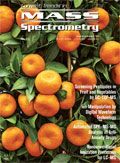
Rapid, Portable Mid-Infrared Spectroscopy Identifies Aflatoxins in Peanuts
March 10th 2025Researchers have developed a portable mid-infrared (IR) spectroscopic method combined with chemometric analysis to rapidly and non-destructively detect aflatoxin contamination in Aspergillus-infected peanuts. This approach offers a field-deployable alternative to traditional wet chemistry methods, with high sensitivity and specificity in identifying toxic metabolites such as aflatoxins.
More Than Just Acronyms at EAS 2023
November 14th 2023Award recipient John McLean of Vanderbilt University said hybrid techniques do not exist purely as combinations of letters, slashes, and hyphens—they have been built on the shoulders of decades’ worth of analysis intended to refine and simplify workflow.
A Look at Rapid Quantification of PFAS in Non-Potable Waters
March 1st 2020The presence of per- and polyfluoralkyl substances (PFAS) in water is an important health and environmental concern. Liquid chromatography–mass spectrometry (LC–MS) has been established as the most suitable technology for monitoring these substances. A method is described, using EPA 8327, for PFAS analysis in groundwater, surface water, and wastewater.
Determination of Very Low Abundance Diagnostic Proteins in Serum Using Immunocapture LC–MS/MS
July 1st 2017There is growing interest in the determination of endogenous proteins in biological samples for diagnostic purposes, because a concentration increase or decrease of such proteins can allows us to monitor the state of a pathological condition such as cancer. Immunocapture LC–MS/MS analysis combines the workflow of conventional immunological assays with LC–MS analysis. This article describes typical challenges, such as cross reactivity and the mass spectrometer’s dynamic range, as well as the advantages of isoform differentiation and multiplexing.
Ion Mobility Spectrometers as Chromatographic Detectors
July 1st 2017Interest in connecting ion mobility spectrometry (IMS) to GC and especially to LC is now growing. One favorable property of IMS is that it can work with ambient pressure and can be easily connected to a gas or liquid chromatograph. Analytical applications of GC–MS and LC–MS are very different and encompass investigations into food, medical science, environment, drugs of abuse, chemical warfare agents, and explosives.